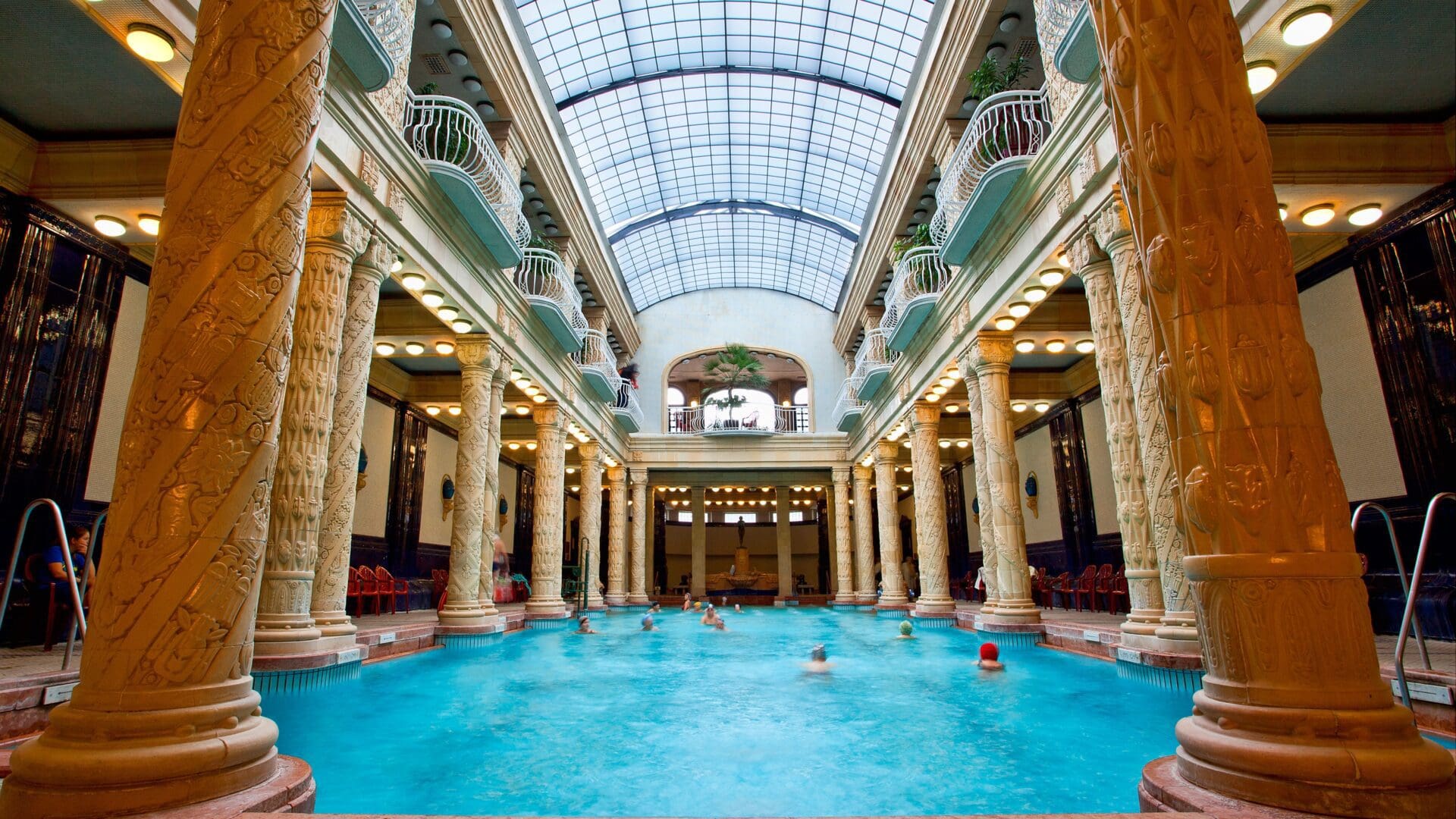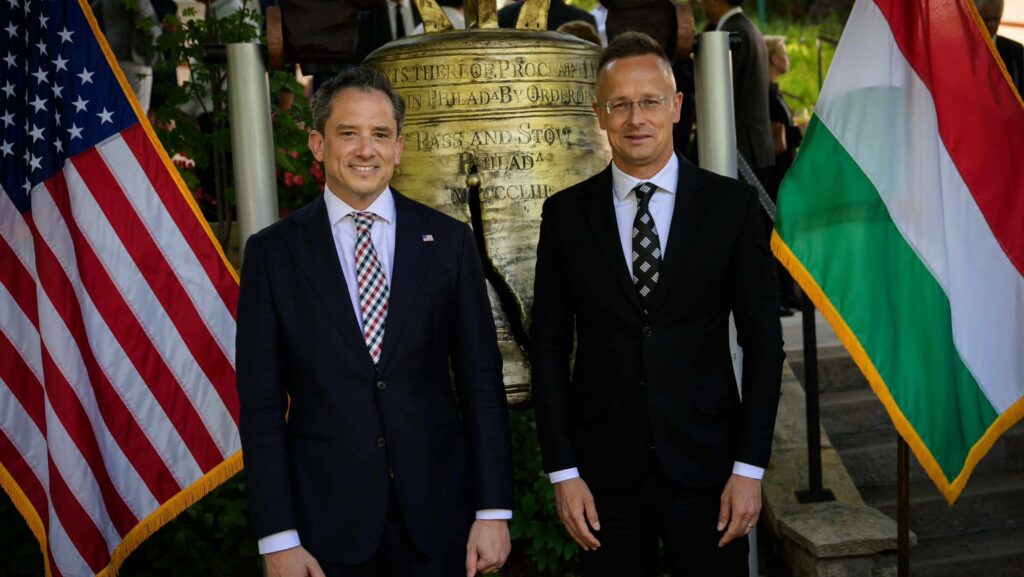Hungary has the world’s fifth-largest thermal water deposit, which is used for medical, touristic, and recreational purposes. Budapest’s spa culture dates back to Roman times, but the Ottoman occupation also greatly impacted the development of the thermal baths found in the capital today. The temperature of the water varies from bath to bath—visitors can enjoy the natural healing water between 21 and 78 degrees Celsius. In our article we provide an overview of the historical thermal baths of Budapest, which are popular destinations for both Hungarians and foreigners.
Széchenyi Thermal Bath
Széchenyi Thermal Bath is the best-known, most visited, and largest thermal bath complex in Budapest. The bath located in City Park has both indoor and outdoor pools, so visitors can relax in the thermal water at a pleasant temperature even in the winter. The history of the Széchenyi Thermal Bath goes back to 1909 when construction began based on Hungarian architect Győző Czigler’s plans. The building opened its doors to visitors in the summer of 1913, and although it survived World War II, it was restored to its original beauty only after its renovation between 1998 and 2006.
Address: 9–11 Állatkerti Boulevard, 1146 Budapest.
Széchenyi Gyógyfürdő és Uszoda 2016
No Description
Gellért Thermal Bath
Gellért Thermal Bath, or as it was called in the 17th century, Sárosfürdő (‘mud bath’ in English), also offers popular programmes for those who want to relax and heal. It got its former name because of the mud that was erupting at the time together with the spring water. Upon entering the building, which has been in operation since 1918, an ornate swimming pool surrounded by columns is revealed to the visitors; the halls of the other thermal pools are also richly decorated with Zsolnay porcelain and astonishing mosaics. In addition to the thermal pools, we can also avail ourselves of various saunas, medical massages, and other wellness services.
Address: 2 Kelenhegyi Road, 1114 Budapest.
Szt. Gellért Gyógyfürdő és Uszoda 2016
No Description
Rudas Thermal Bath
The edifice of Rudas Thermal Bath has been standing ever since the time of the Ottoman occupation, and its operation has been uninterrupted since 1520. Its characteristic, 10-metre-diametre dome is supported by eight columns, and the octagonal pool inside offers a breath-taking view of the Danube and Gellért Hill. It may come as a surprise that until 2005, only men could visit the bath, but nowadays women are also allowed to enter. Various wellness and medical services can also be used in Rudas, and anyone who gets hungry while bathing all day can comfortably choose from every kind of Hungarian and international dish on the terrace of the Rudas Bistro with a panoramic view of the Danube.
Address: 9 Döbrentei Square, 1013 Budapest.
Rudas Gyógyfürdő és Uszoda
No Description
Lukács Thermal Bath
Lukács Thermal Bath was the first bath in Budapest that created a complex thermal spa department and it still provides extensive medical treatments to this day. The spa also has a refreshments bar, and Budapest’s only hot mud bath is located here as well. Since its modernisation in 1999, an additional adventure pool has also been at the service of visitors, with neck showers, massage seats, fizzy beds, lazy rivers, and many other exciting features in it.
Address: 25–29 Frankel Leó Road, 1023 Budapest.
Kalandjárat a Szent Lukács Gyógyfürdőben
No Description
Dagály Bath
Dagály Bath is located on the Pest side of Árpád Bridge and has been open to visitors since 1948. From 1970 to 2013, the spa’s thermal water was supplied by the spring of the Széchenyi Thermal Bath, but nowadays it is already provided by the Béke (Peace) Well in the part of town called Angyalföld. In 2017, Dagály Bath received a lot of attention worldwide, as it provided the venue for the 17th FINA World Championships, thus Danube Arena was built nearby. In 2018, after the World Championships, the bath opened its doors in a renovated form and with additional services, including new playgrounds, several renewed pools, as well as a new sports and fitness park. In addition, a new wing was also built where wellness and medical services can be used.
Address: 28–30 Népfürdő Street, 1138 Budapest.
Dandár Thermal Bath
Dandár Thermal Bath, located in the 9th district with its own well, was opened in 1930 and then underwent a complete transformation in 1936. Although the building was slightly damaged during WWII, the bath continued to operate from 1945. Since 2014, two outdoor adventure pools and a sauna world have also been added to the complex, and the thermal pool section has undergone further renovation, too. The specialists of Dandár Thermal Bath offer thermotherapy, balneotherapy, hydrotherapy, mechanotherapy, and aromatherapy to those who wish to relax and cure.
Address: 3 Dandár Street, 1095 Budapest.
Király Thermal Bath
Király Thermal Bath has a long history: it was the Ottoman Arslan Pasha of Buda who started the spa’s construction in the 16th century, which was then completed under the rule of his successor Sokoli Mustafa. During the Turkish era, this bath was built far from the springs, because they wanted to ensure the possibility of bathing even in the event of a siege. The bath’s water supply was and is still provided from the area of Lukács Thermal Bath. However, WWII did not spare this spa either—the damaged edifice of the bath was renovated in 1950, so since then, a steam cabin, Finnish sauna, hot air chamber, hot tub, underwater-jet massage, and other services can also be found in it. As of this writing, Király Thermal Bath was closed for an indefinite period.
Address: 84 Fő Street, 1027 Budapest.
Thanks to the thermal springs of the capital, Budapest’s spa culture clearly dates back several centuries. Although most of the baths have already undergone a complete renovation, traces of the past are still visible today. Whether we want to take advantage of the healing power of the thermal water or simply relax a little, all of the capital’s baths are definitely worth a visit!
Related articles:
Click here to read the original article.








